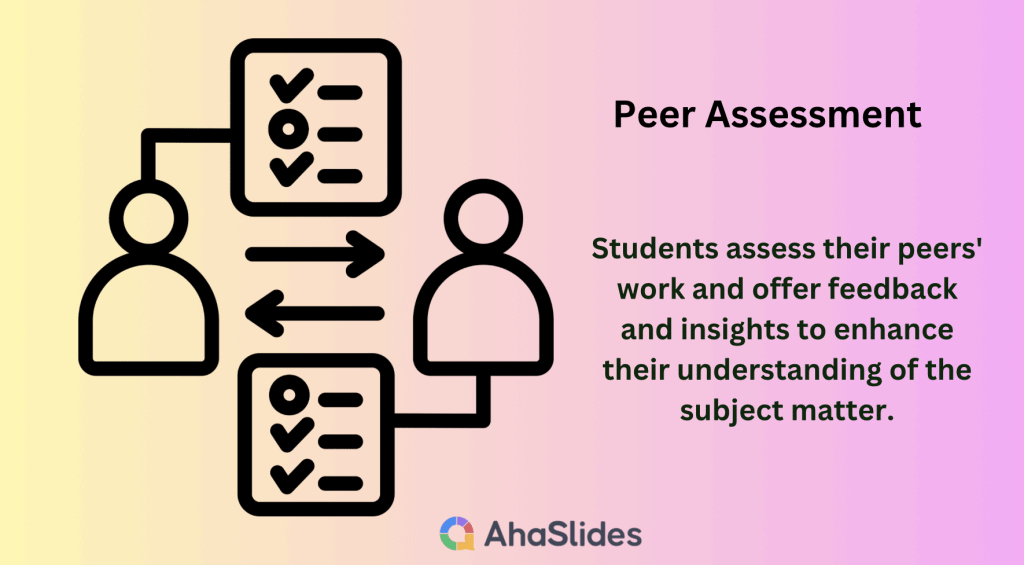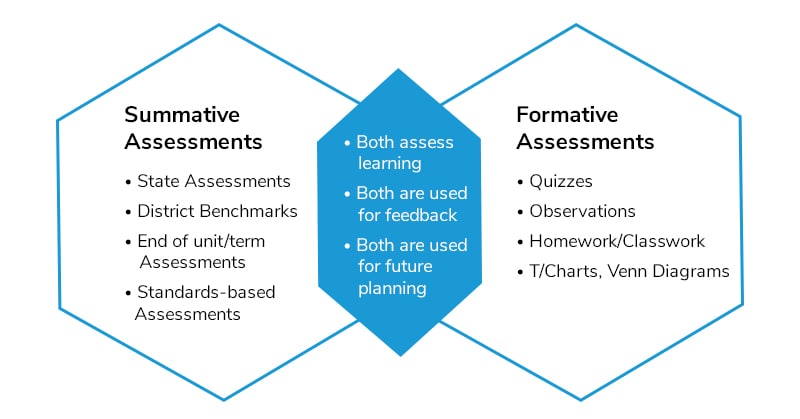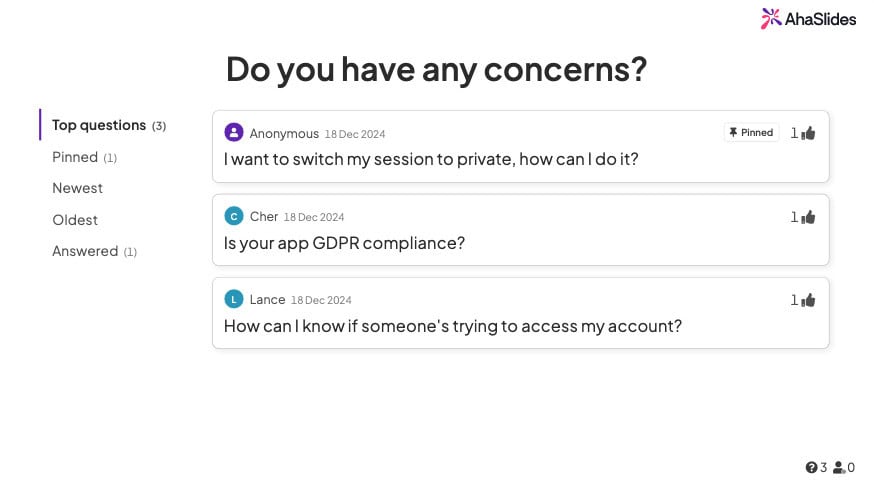What is the best use of peer assessment? Peer assessment is a common way in classroom learning, and is promoted by teachers to help every member of the team evaluate the contributions of their fellow students to group work and assignments. Nowadays, this method is popularly used in various aspects, in business context and peer review.
Peer assessment doesn't need to be so severe or anxiety-inducing, there are several ways to make peer assessment effective and engaging. This article suggests the best peer assessment examples that enable everyone to provide constructive feedback and support one another's growth.
Table of Contents
- What is Peer Assessment?
- What are the Types of Peer Assessment?
- Peer Assessment Examples with Writing Checklist
- What are Good Peer Assessment Examples?
- Key Takeaways
- Frequently Asked Questions
What is Peer Assessment?
Peer assessment is a method of evaluation that involves having students review, analyze, and provide feedback on the work of their peers. It fosters critical thinking skills and a sense of responsibility and has become a valuable tool in various contexts, from education to the workplace and the realm of academic research.

Student Peer Assessment
Peer assessment has its origin in education, where students assess their peers' work and offer feedback and insights to enhance their understanding of the subject matter. This approach goes beyond traditional evaluation and promotes an environment where students actively engage with the learning material.
Employee Peer Assessment
Similarly, employee peer appraisal plays a key role in personal and professional development. It encourages team members to provide feedback about the performance, behaviors, and contributions of their colleagues and helps foster a culture of continuous improvement within the organization.
Peer Journal or Article Assessment
It is also common to see Peer journal or article assessment, which refers to an act of guaranteeing the content of a research paper or article meets rigorous academic standards. It often follows a double-blind review system, maintaining anonymity between authors and reviewers to eliminate bias.
What are the Types of Peer Assessment?
The two most popular types of peer assessment include formative and summative feedback. They show differences in distinct approaches with different aims and outcomes. Understanding the differences between these two types is essential for effectively implementing peer assessment in different situations.

Formative Feedback
Formative assessment is a dynamic process designed to support ongoing learning and improvement. It provides individuals with feedback and insights to help them understand their strengths and weaknesses, make necessary adjustments, and enhance their performance. For example, students are asked to exchange their rough drafts with a peer for feedback before final submission.
Summative Feedback
Summative assessment, in contrast, is designed for evaluation and judgment. It serves to measure the final performance or achievement of an individual. Summative peer assessment often carries higher stakes, as it can impact grading, certification, or final decisions. For instance, as the course concludes, the student's work is evaluated through a summative assessment process.
Peer Assessment Examples with Writing Checklist
If you are looking for a sample of this kind of assessment, you can refer to the following template. It includes a list of important points for constructive feedback. Note that this sample is for evaluation for presentation.
Content (Score out of 10):
- The presentation topic is clearly defined and well explained.
- The introduction provides context and engages the audience.
- The main points are organized logically.
- The content is factually accurate and supported by relevant sources.
- The conclusion effectively summarizes the key points.
Delivery (Score out of 10):
- The presenter maintains eye contact with the audience.
- The speaker uses a clear and appropriate tone of voice.
- The pace of the presentation is suitable for the content.
- Visual aids, if used, are effective and enhance understanding.
- The presenter responds well to questions and engages with the audience.
Structure (Score out of 10):
- The presentation has a clear structure, including an introduction, body, and conclusion.
- Transitions between points are smooth and well-organized.
- The presenter uses signposting to guide the audience through the presentation.
- The presentation adheres to the time limit.
- The presenter engages the audience and encourages participation.
Visuals (Score out of 10):
- Slides or visual aids are clear, well-designed, and enhance understanding.
- Visuals are not cluttered with excessive text or distracting elements.
- Graphics, charts, or images are relevant and effectively support the content.
- Visuals are appropriately cited and used ethically.
- Visuals contribute to the overall quality of the presentation.
Overall Impressions (Score out of 10):
- The presentation was informative and engaging.
- The presenter demonstrated a deep understanding of the topic.
- The presentation was well-prepared and rehearsed.
- The presenter effectively conveyed the main message or takeaways.
- Any areas for improvement or suggestions for the presenter:
Additional Comments (if any):...
What are Good Peer Assessment Examples?
As mentioned. It is possible to make peer appraisal look more interesting and effective. Here are eight peer assessment examples that completely transform the process of evaluation and feedback.

- Anonymous peer assessment examples: Anonymity can promote honest and candid feedback. This can be done online through feedback features from virtual tools like AhaSlides, enabling participants to share insights and evaluations without the pressure of identification.
- Peer Online Quiz and Polls are excellent peer assessment examples if you aim to create interactive and intermediate peer appraisals. For example, students can create quizzes or self-assessments and share them with their peers for review. Peers can evaluate the quality of the questions, the accuracy of the answers, and the overall effectiveness of the quiz. This process encourages collaboration and critical assessment.
- Bloom's Taxonomy: Applying Bloom's Taxonomy to peer review expands the evaluation process beyond basic knowledge. It encourages peers to assess various cognitive levels, promoting critical thinking, analysis, and synthesis. This approach helps learners grasp complex concepts and deepen their understanding.
- Brainstorming in Groups: can be a highly engaging approach to conducting peer review. For example, a cross-functional team in a product development department conducts a peer review of a new product prototype. They brainstorm solutions to enhance product quality, identify potential defects, and brainstorm creative improvements.
- Learner Conferences: Personalized learner conferences, whether one-on-one or in small groups, provide tailored feedback and guidance. This approach fosters motivation and helps individuals set and achieve specific learning goals.
- Feedback Sandwich Technique: Many great peer assessment examples often start and end with positive feedback, it is also known as sandwiching constructive criticism model. This technique ensures that feedback is both comprehensive and constructive, motivating improvement.
- Testing Preview With a Buddy: Pairing up for test preparation is an engaging approach to peer assessment. Participants create practice quizzes or tests for each other, exposing themselves to different perspectives and question styles, leading to deeper understanding.
- 360-Degree Feedback: In a professional context, 360-degree feedback involves assessments from peers, managers, subordinates, and self-assessment. This broad approach offers a well-rounded view of an individual's performance and development needs. It enhances professional growth and aligns individual development with organizational goals.
Key Takeaways
💡In the end, peer review isn't just about checking papers or critiquing presentations - it's about growing together. Make the process a fun learning experience rather than a chore with AhaSlides' powerful features, where you can gain what people think by polling, quizzes, or everything in between!
Frequently Asked Questions
What are examples of peer assessment?
One of the most common peer assessment examples is students giving feedback to students during class learning. It can be feedback for a presentation, a video, an answer, and more.
What are peer assessment activities?
It includes students in the act of evaluating and providing feedback on the work of their peers. This activity benefits both the feedback giver and the taker. It is sometimes more practical and effective to learn from peers.
How can students peer assess?
This can be done in a range of forms, such as verbal appraisals, online feedback (anonymity setting if necessary), and written forms with a checklist.
How do you create an assessment for peers?
The most convenient way is following checklists that are available to download from trusted sources. Leveraging online feedback tools is also a great choice for making instant evaluations constructively. AhaSlides offers various ready-made templates for users to customize easily.
Ref: Indeed | future focus








